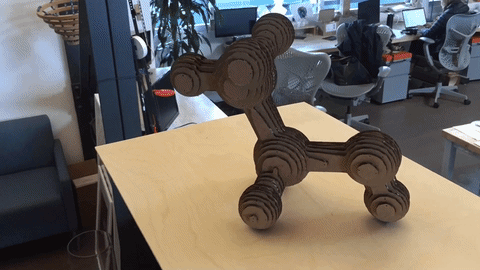Orbiting Time Lapse Rig


Time-lapse footage of a build is interesting but the fixed viewpoint restricts how much detail gets seen. When you watch someone work on a project, you rarely stay in one spot - you move around to get a variety of angles on the scene. We don't all have a tireless videographer around to simulate this, but with a few inexpensive components you can make an orbiting time lapse rig that generates compelling build videos like the one below (above video is fellow AiR Alex Reed crafting some shoes).
I was intrigued to see Frank Howarth made a similar rig recently - while he hadn't published his video when I first put this together, he has been a real inspiration to how I document my work visually. His rig is much more elaborate than mine - go check it out.
Design


Design is a little more complex than for the normal panning design because the rig needs to be hung and it has to be strong enough to support the camera, the rotating boom and the counterweight. I decided to go with off-the-shelf components: a length of 3/4" PVC pipe, a pipe clamp, a selfie stick and a time lapse tripod head. Because there are steel beams around at the Pier I used magnets to attach the tripod head upside down. You will also need a bolt with 1/4"-20 thread for suspending the rig from cords.
Not interested in forking out $100 for the tripod head? You might be tempted to make one with a hose timer instead. However, I tried exactly that, and it failed: the clockwork mechanism is just not strong enough to run under this sort of load, and it stops often and needs to be nudged back into life. It might work if you have a lighter phone/camera than mine.
Assembly






Remove the cap from the end of the selfie stick and cut off the rubber handle with a knife. The diameter is slightly less than the internal diameter of the PVC tube, and there is a hole at a convenient distance which should be marked on the PVC. A hole can be drilled and a screw used to securely pin the selfie stick in place. Attach the pipe clamp to the approximate center of the tube. Put a counterweight on the far end if you want a large radius: the beam needs to be perfectly balanced. Using an iPhone6+ as the camera, the 5' PVC pipe itself (in conjunction with the telescoping selfie stick) can describe circles up to 7' (2.1 m) in diameter. Adding a counterweight will get you a few more inches (picture shows a roll of tape), but you can't add too much without overloading the panning mount. A lighter camera would help, too - a GoPro or a lightweight phone would be perfect. If you have different lengths of PVC pipe and some elbow joints, you will have more flexibility in your set up.
I mounted the tripod head two ways: one via swapping the screws out on the back for longer ones that passed through some large donut-shaped rare-earth magnets (thanks Vanessa for this suggestion), and another by tying 3 cords to a bolt. The suspended rig is more practical for most scenarios since the chances of having a steel beam in the right place for a build is frankly quite low, but the rig also needs to be carefully balanced and will wobble in a breeze.
Showcase Your Work


Got something cool you made and want to show it off from all sides? Set it up under the panning head and do a fast 360 (5 minutes is the fastest on my tripod head) with time lapse mode on your phone. This is great to turn into animated gifs, as shown above. I made it using giphy, which is about as self-explanatory a website as it gets - upload your movie, download the gif. It's worth accelerating and compressing the movie first - I used the iMovie app for that. The object above is a cardboard model of ethanol, from my molecular modelling instructable.
Below is a wooden beer stein I borrowed from mikeasaurus (it was made for him by bricobart). I recorded the recording itself, so you can see how it works.


Showcase a Build
Doing a fun assembly? The one above is me fabricating a molecular model out of plywood and woodglue. I set it up for an hour but it only took a little over half that time, hence the rotation is incomplete. I learned something here - leave the finished work in place for a while once you're done, and keep recording so people can see what it is you made!
Here's another one, where I'm assembling a topographical map. This one I set up using a 45 degree angle joint, so the viewpoint is lower. This had the uncomfortable side effect of providing a closeup of the back of my head, so you miss the start of the build (I cropped the movie). Best to start it just after your head and end just before. I'm still learning as I go here...
Side note: I figured out an easy way of making these sorts of maps - look out for it in an upcoming instructable.
Feel free to post a comment if you have any questions, and be sure to let me know if you make such a rig yourself, I'd love to see the results.